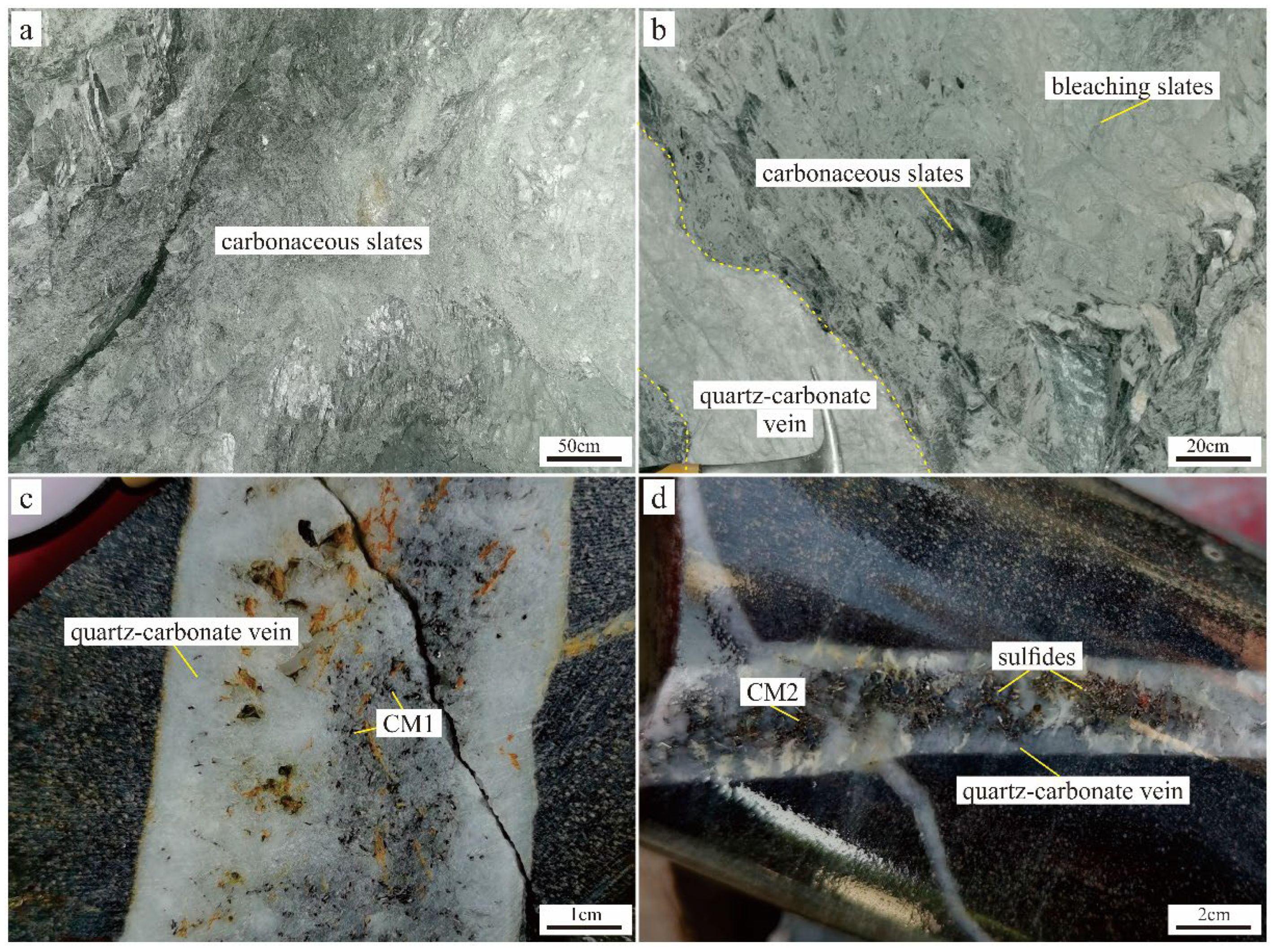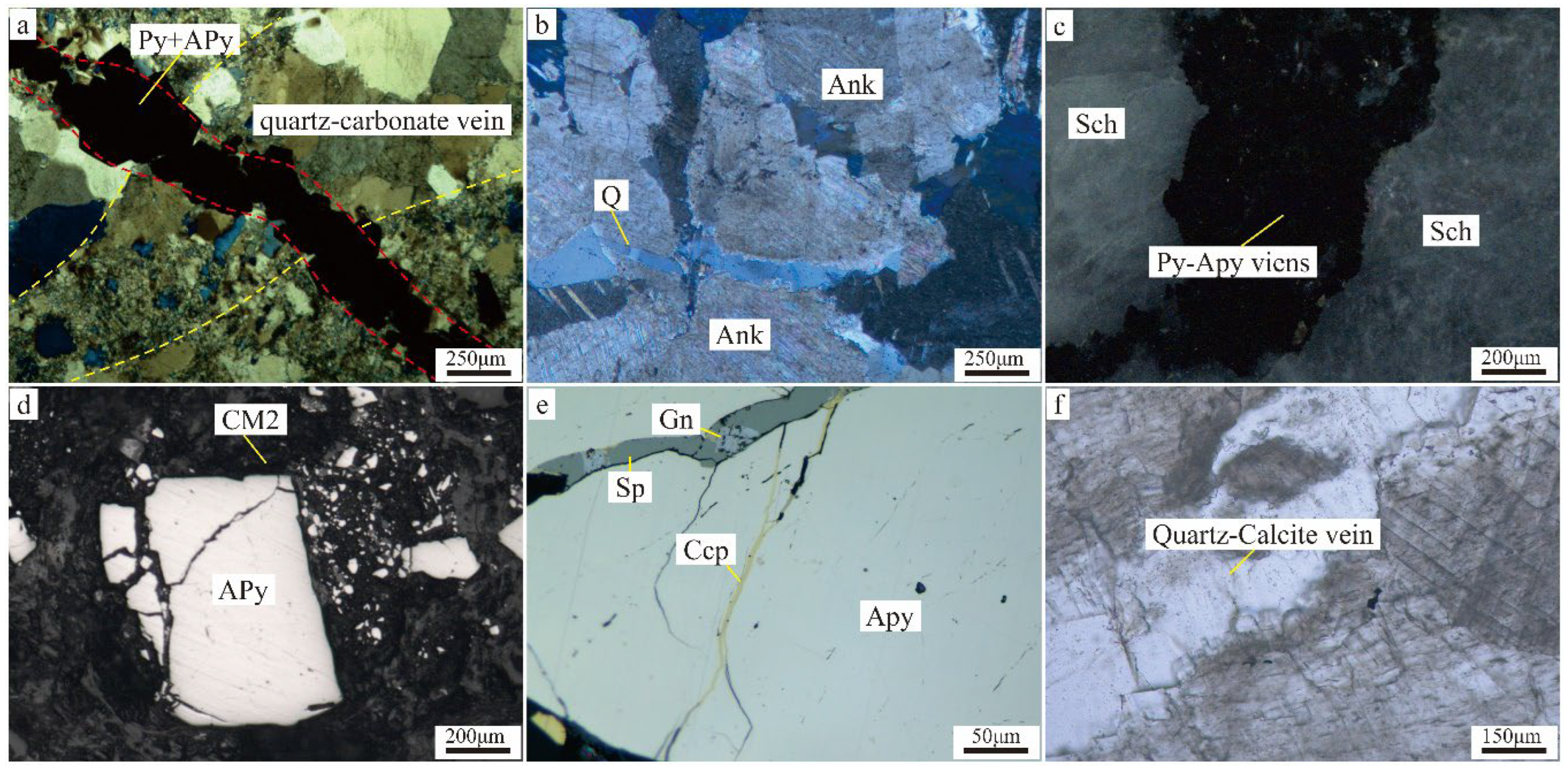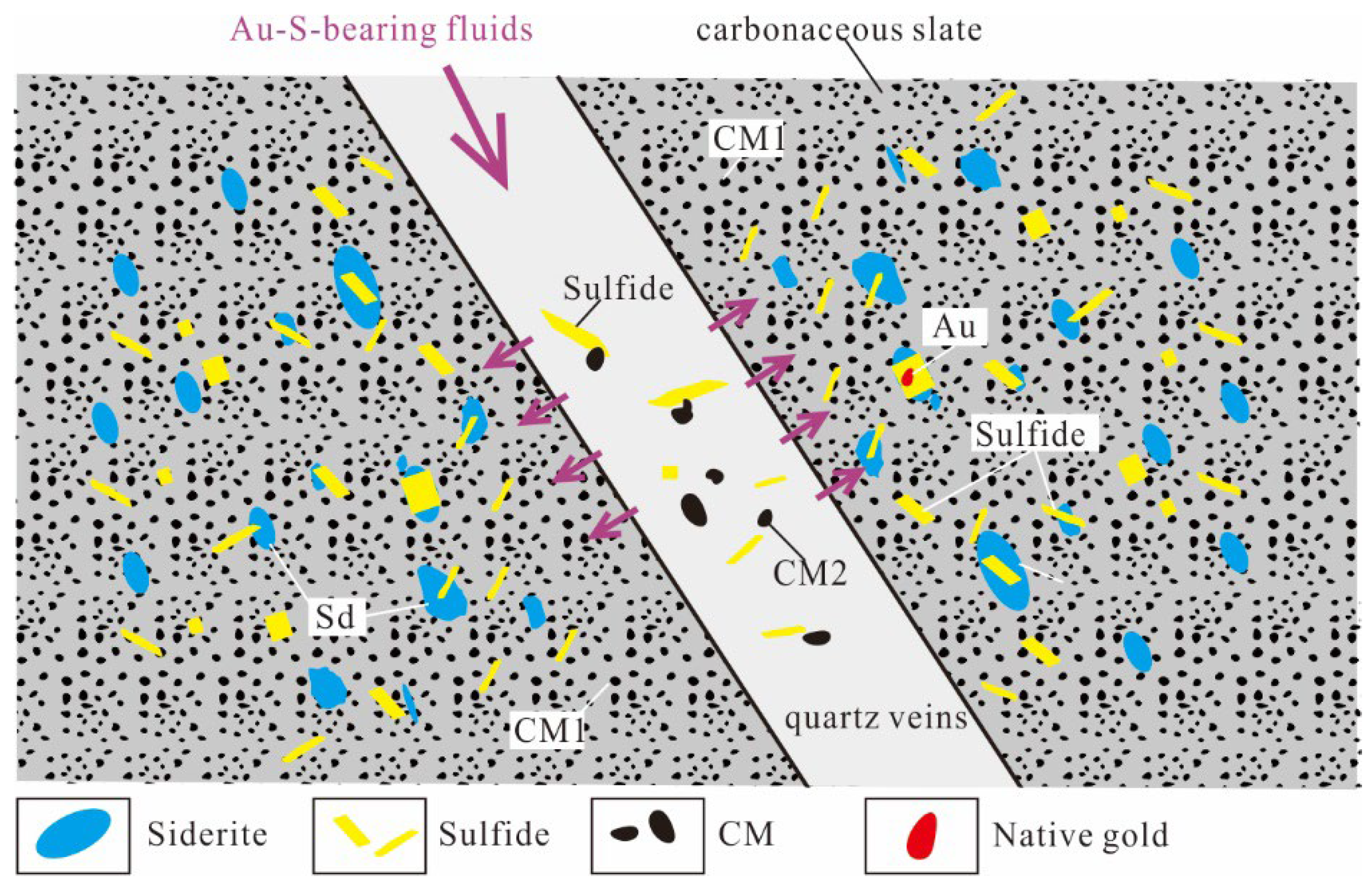The Contribution of Carbonaceous Material to Gold Mineralization in the Huangjindong Deposit, Central Jiangnan Orogen, China
Abstract
1. Introduction
2. Regional Geology
3. Ore Deposit Geology
4. Samples and Analytical Methods
4.1. Raman Spectroscopy
4.2. Geochemical Modeling
5. Results
5.1. Petrographic Work
5.2. Raman Analysis of CM
5.3. Geochemical Modeling
6. Discussion
6.1. Characteristics and Genesis of CM
6.2. Implications for Gold Mineralization
Au(s) + O2(aq) + H+ + AsFeS (Arsenopyrite) + H2O + HCO3−
7. Conclusions
Author Contributions
Funding
Data Availability Statement
Conflicts of Interest
References
- Groves, D.I.; Goldfarb, R.J.; Robert, F.; Hart, C.J. Gold Deposits in Metamorphic Belts: Overview of Current Understanding, Outstanding Problems, Future Research, and Exploration Significance. Econ. Geol. 2003, 98, 1–29. [Google Scholar] [CrossRef]
- Hu, S.; Evans, K.; Craw, D.; Rempel, K.; Bourdet, J.; Dick, J.; Grice, K. Raman Characterization of Carbonaceous Material in the Macraes Orogenic Gold Deposit and Metasedimentary Host Rocks, New Zealand. Ore Geol. Rev. 2015, 70, 80–95. [Google Scholar] [CrossRef]
- Wu, Y.-F.; Evans, K.; Fisher, L.A.; Zhou, M.-F.; Hu, S.-Y.; Fougerouse, D.; Large, R.R.; Li, J.-W. Distribution of Trace Elements between Carbonaceous Matter and Sulfides in a Sediment-Hosted Orogenic Gold System. Geochim. Cosmochim. Acta 2020, 276, 345–362. [Google Scholar] [CrossRef]
- Wang, C.; Shao, Y.; Evans, N.J.; Li, H.; Huang, K.; Liu, Z.; Chen, Y.; Lai, C.; Liu, Q. Genesis of Zixi Gold Deposit in Xuefengshan, Jiangnan Orogen (South China): Age, Geology and Isotopic Constraints. Ore Geol. Rev. 2020, 117, 103301. [Google Scholar] [CrossRef]
- Kříbek, B.; Sỳkorová, I.; Machovič, V.; Knésl, I.; Laufek, F.; Zachariáš, J. The Origin and Hydrothermal Mobilization of Carbonaceous Matter Associated with Paleoproterozoic Orogenic-Type Gold Deposits of West Africa. Precambrian Res. 2015, 270, 300–317. [Google Scholar] [CrossRef]
- Hu, S.-Y.; Evans, K.; Craw, D.; Rempel, K.; Grice, K. Resolving the Role of Carbonaceous Material in Gold Precipitation in Metasediment-Hosted Orogenic Gold Deposits. Geology 2017, 45, 167–170. [Google Scholar] [CrossRef]
- Beny-Bassez, C.; Rouzaud, J.N. Characterization of Carbonaceous Materials by Correlated Electron and Optical Microscopy and Raman Microspectroscopy. Scanning Electron Microsc. 1984, 1985, 11. [Google Scholar]
- Leventhal, J.S.; Grauch, R.I.; Threlkeld, C.N.; Lichte, F.E.; Harper, C.T. Unusual Organic Matter Associated with Uranium from the Claude Deposit, Cluff Lake, Canada. Econ. Geol. 1987, 82, 1169–1176. [Google Scholar] [CrossRef]
- Lewan, M.D.; Bjorøy, M.; Dolcater, D.L. Effects of Thermal Maturation on Steroid Hydrocarbons as Determined by Hydrous Pyrolysis of Phosphoria Retort Shale. Geochim. Cosmochim. Acta 1986, 50, 1977–1987. [Google Scholar] [CrossRef]
- Cox, S.F.; Sun, S.S.; Etheridge, M.A.; Wall, V.J.; Potter, T.F. Structural and Geochemical Controls on the Development of Turbidite-Hosted Gold Quartz Vein Deposits, Wattle Gully Mine, Central Victoria, Australia. Econ. Geol. 1995, 90, 1722–1746. [Google Scholar] [CrossRef]
- Craw, D.; MacKenzie, D.; Grieve, P. Supergene Gold Mobility in Orogenic Gold Deposits, Otago Schist, New Zealand. N. Z. J. Geol. Geophys. 2015, 58, 123–136. [Google Scholar] [CrossRef]
- Xu, D.; Guoxiang, C.; Yanhua, Z.; Zhaochong, Z.; Weidong, S. Yanshanian (Late Mesozoic) Ore Deposits in China–an Introduction to the Special Issue. Ore Geol. Rev. 2017, 88, 481–490. [Google Scholar]
- Shu, L.; Charvet, J. Kinematics and Geochronology of the Proterozoic Dongxiang-Shexian Ductile Shear Zone: With HP Metamorphism and Ophiolitic Melange (Jiangnan Region, South China). Tectonophysics 1996, 267, 291–302. [Google Scholar] [CrossRef]
- Wang, X.-L.; Zhou, J.-C.; Qiu, J.-S.; Zhang, W.-L.; Liu, X.-M.; Zhang, G.-L. LA-ICP-MS U-Pb Zircon Geochronology of the Neoproterozoic Igneous Rocks from Northern Guangxi, South China: Implications for Tectonic Evolution. Precambrian Res. 2006, 145, 111–130. [Google Scholar] [CrossRef]
- Yao, J.; Shu, L.; Santosh, M.; Zhao, G. Neoproterozoic Arc-Related Mafic–Ultramafic Rocks and Syn-Collision Granite from the Western Segment of the Jiangnan Orogen, South China: Constraints on the Neoproterozoic Assembly of the Yangtze and Cathaysia Blocks. Precambrian Res. 2014, 243, 39–62. [Google Scholar] [CrossRef]
- Shu, L.-S.; Faure, M.; Yu, J.-H.; Jahn, B.-M. Geochronological and Geochemical Features of the Cathaysia Block (South China): New Evidence for the Neoproterozoic Breakup of Rodinia. Precambrian Res. 2011, 187, 263–276. [Google Scholar] [CrossRef]
- Shu, L.S.; Jahn, B.-M.; Charvet, J.; Santosh, M.; Wang, B.; Xu, X.S.; Jiang, S.Y. Early Paleozoic Depositional Environment and Intraplate Tectono-Magmatism in the Cathaysia Block (South China): Evidence from Stratigraphic, Structural, Geochemical and Geochronological Investigations. Am. J. Sci. 2014, 314, 154–186. [Google Scholar] [CrossRef]
- Zhao, G.; Cawood, P.A. Precambrian Geology of China. Precambrian Res. 2012, 222, 13–54. [Google Scholar] [CrossRef]
- Charvet, J. The Neoproterozoic–Early Paleozoic Tectonic Evolution of the South China Block: An Overview. J. Asian Earth Sci. 2013, 74, 198–209. [Google Scholar] [CrossRef]
- Pirajno, F.; Bagas, L. Gold and Silver Metallogeny of the South China Fold Belt: A Consequence of Multiple Mineralizing Events? Ore Geol. Rev. 2002, 20, 109–126. [Google Scholar] [CrossRef]
- Charvet, J.; Shu, L.; Shi, Y.; Guo, L.; Faure, M. The Building of South China: Collision of Yangzi and Cathaysia Blocks, Problems and Tentative Answers. J. Southeast Asian Earth Sci. 1996, 13, 223–235. [Google Scholar] [CrossRef]
- Sun, W.-D.; Yang, X.-Y.; Fan, W.-M.; Wu, F.-Y. Mesozoic Large Scale Magmatism and Mineralization in South China: Preface. Lithos 2012, 150, 1–5. [Google Scholar] [CrossRef]
- Mao, J.; Li, H.; Xu, J.; Luo, F.T.; Li, Y.S.; Yi, Z.S.; Gu, J.N. Geology and Genesis of the Wangu Gold Deposit in Hunan Province, China; Atomic Energy Press: Beijing, China, 1998; (In Chinese with English Abstract). [Google Scholar]
- Xu, D.; Zhuanli, H.; Pengchun, L.; Guanghao, C.; Bin, X.; Gonggu, F. Discovery of the Late Yanshanian Spilitic Basalts in Northeastern Hunan Province and Its Geological Implications. Chin. J. Geol. 2006, 41, 311–332. [Google Scholar]
- Zhao, C.; Ni, P.; Wang, G.-G.; Ding, J.-Y.; Chen, H.; Zhao, K.-D.; Cai, Y.-T.; Xu, Y.-F. Geology, Fluid Inclusion, and Isotope Constraints on Ore Genesis of the Neoproterozoic Jinshan Orogenic Gold Deposit, South China. Geofluids 2013, 13, 506–527. [Google Scholar] [CrossRef]
- Guan, Y.; Yuan, C.; Sun, M.; Wilde, S.; Long, X.; Huang, X.; Wang, Q. I-Type Granitoids in the Eastern Yangtze Block: Implications for the Early Paleozoic Intracontinental Orogeny in South China. Lithos 2014, 206, 34–51. [Google Scholar] [CrossRef]
- Jia, D.; Hu, R.; Zhao, J.; Xie, G. Lithogeochemical Characteristics of the Mesozoic Granitic Intrusion from the Wangxiang Area in Northeastern Hunan Province and Its Tectonic Setting. Acta Geol. Sin.-Chin. Ed. 2003, 77, 97–103. [Google Scholar]
- Li, Z.-X.; Li, X.-H. Formation of the 1300-Km-Wide Intracontinental Orogen and Postorogenic Magmatic Province in Mesozoic South China: A Flat-Slab Subduction Model. Geology 2007, 35, 179–182. [Google Scholar] [CrossRef]
- Wang, L.-X.; Ma, C.-Q.; Zhang, C.; Zhang, J.-Y.; Marks, M.A. Genesis of Leucogranite by Prolonged Fractional Crystallization: A Case Study of the Mufushan Complex, South China. Lithos 2014, 206, 147–163. [Google Scholar] [CrossRef]
- DeRu, X.; Li, W.; PengChun, L.; GuangHao, C.; ZhuanLi, H.; GongGu, F.; Jun, W. Petrogenesis of the Lianyunshan Granites in Northeastern Hunan Province, South China, and Its Geodynamic Implications. Acta Petrol. Sin. 2009, 25, 1056–1078. [Google Scholar]
- Deng, T.; Xu, D.; Chi, G.; Wang, Z.; Chen, G.; Zhou, Y.; Li, Z.; Ye, T.; Yu, D. Caledonian (Early Paleozoic) Veins Overprinted by Yanshanian (Late Mesozoic) Gold Mineralization in the Jiangnan Orogen: A Case Study on Gold Deposits in Northeastern Hunan, South China. Ore Geol. Rev. 2020, 124, 103586. [Google Scholar] [CrossRef]
- Xiao, Y.; Chen, G. Preliminary Study on the Tectono-Metallogenic Orientation Mechanism of the Da Dong-Wangu Gold Deposit Zone, Northeastern Hunan Province. Geotecton. Metallog. 2004, 1, 5. [Google Scholar]
- Sun, S.; Liang, Z.; ShengGang, W.; Lei, G.; JinSong, P.; Ting, W. Metallogenic Mechanism of the Huangjindong Gold Deposit, Jiangnan Orogenic Belt: Constraints from Mineral Formation Environment and Physicochemical Conditions of Metallogenesis. Acta Petrol. Sin. 2018, 34, 1469–1483. [Google Scholar]
- Beyssac, O.; Goffé, B.; Chopin, C.; Rouzaud, J.N. Raman Spectra of Carbonaceous Material in Metasediments: A New Geothermometer. J. Metamorph. Geol. 2002, 20, 859–871. [Google Scholar] [CrossRef]
- Beyssac, O.; Rouzaud, J.-N.; Goffé, B.; Brunet, F.; Chopin, C. Graphitization in a High-Pressure, Low-Temperature Metamorphic Gradient: A Raman Microspectroscopy and HRTEM Study. Contrib. Mineral. Petrol. 2002, 143, 19–31. [Google Scholar] [CrossRef]
- Lespade, P.; Marchand, A.; Couzi, M.; Cruege, F. Caracterisation de Materiaux Carbones Par Microspectrometrie Raman. Carbon 1984, 22, 375–385. [Google Scholar] [CrossRef]
- Bethke, C. Reaction Modelling Guide, The Geochemist’s Workbench Release 6, User’s Guide to React and Gtplot. Univ. Ill. Hydrogeol. Program 2005, 74, 1–198. [Google Scholar]
- Bethke, C.M. The Geochemist’s Workbench, Version 6.0; A User’s Guide to Rxn, Act2, Tact, SpecE8, and Aqplot, Hydrogeology Program; Oxford University Press: Oxford, UK, 2006; pp. 1–186. [Google Scholar]
- Johnson, C.A.; Day, W.C.; Rye, R.O. Oxygen, Hydrogen, Sulfur, and Carbon Isotopes in the Pea Ridge Magnetite-Apatite Deposit, Southeast Missouri, and Sulfur Isotope Comparisons to Other Iron Deposits in the Region. Econ. Geol. 2016, 111, 2017–2032. [Google Scholar] [CrossRef]
- Zimmer, K.; Zhang, Y.; Lu, P.; Chen, Y.; Zhang, G.; Dalkilic, M.; Zhu, C. SUPCRTBL: A Revised and Extended Thermodynamic Dataset and Software Package of SUPCRT92. Comput. Geosci. 2016, 90, 97–111. [Google Scholar] [CrossRef]
- Simmons, S.F.; Tutolo, B.M.; Barker, S.L.; Goldfarb, R.J.; Robert, F. Hydrothermal Gold Deposition in Epithermal, Carlin, and Orogenic Deposits. In Geology of the World’s Major Gold Deposits and Provinces; Society of Economic Geologists: Littleton, CO, USA, 2020. [Google Scholar]
- Lehmann, B.; Nägler, T.F.; Holland, H.D.; Wille, M.; Mao, J.; Pan, J.; Ma, D.; Dulski, P. Highly Metalliferous Carbonaceous Shale and Early Cambrian Seawater. Geology 2007, 35, 403–406. [Google Scholar] [CrossRef]
- Mossman, D.J. Carbonaceous Substances in Mineral Deposits: Implications for Geochemical Exploration. J. Geochem. Explor. 1999, 66, 241–247. [Google Scholar] [CrossRef]
- Gaboury, D. The Neglected Involvement of Organic Matter in Forming Large and Rich Hydrothermal Orogenic Gold Deposits. Geosciences 2021, 11, 344. [Google Scholar] [CrossRef]
- Luque del Villar, F.J.; Pasteris, J.D.; Wopenka, B.; Rodas, M.; Fernández Barrenechea, J.M. Natural Fluid-Deposited Graphite: Mineralogical Characteristics and Mechanisms of Formation. Am. J. Sci. 1998, 298, 471–498. [Google Scholar] [CrossRef]
- Teichmüller, M. Organic Petrology of Source Rocks, History and State of the Art. Org. Geochem. 1986, 10, 581–599. [Google Scholar] [CrossRef]
- Oohashi, K.; Hirose, T.; Kobayashi, K.; Shimamoto, T. The Occurrence of Graphite-Bearing Fault Rocks in the Atotsugawa Fault System, Japan: Origins and Implications for Fault Creep. J. Struct. Geol. 2012, 38, 39–50. [Google Scholar] [CrossRef]
- Liu, Q.; Shao, Y.; Chen, M.; Algeo, T.J.; Li, H.; Dick, J.M.; Wang, C.; Wang, W.-S.; Li, Z.; Liu, Z. Insights into the Genesis of Orogenic Gold Deposits from the Zhengchong Gold Field, Northeastern Hunan Province, China. Ore Geol. Rev. 2019, 105, 337–355. [Google Scholar] [CrossRef]
- Li, W.; Cook, N.J.; Xie, G.-Q.; Mao, J.-W.; Ciobanu, C.L.; Li, J.-W.; Zhang, Z.-Y. Textures and Trace Element Signatures of Pyrite and Arsenopyrite from the Gutaishan Au–Sb Deposit, South China. Minim. Depos. 2019, 54, 591–610. [Google Scholar] [CrossRef]
- Zhang, L.; Groves, D.I.; Yang, L.-Q.; Sun, S.-C.; Weinberg, R.F.; Wang, J.-Y.; Wu, S.-G.; Gao, L.; Yuan, L.-L.; Li, R.-H. Utilization of Pre-Existing Competent and Barren Quartz Veins as Hosts to Later Orogenic Gold Ores at Huangjindong Gold Deposit, Jiangnan Orogen, Southern China. Min. Depos. 2020, 55, 363–380. [Google Scholar] [CrossRef]
- Williams-Jones, A.E.; Bowell, R.J.; Migdisov, A.A. Gold in Solution. Elements 2009, 5, 281–287. [Google Scholar] [CrossRef]
- McKeag, S.A.; Craw, D.; Norris, R.J. Origin and Deposition of a Graphitic Schist-Hosted Metamorphogenic Au-W Deposit, Macraes, East Otago, New Zealand. Miner. Depos. 1989, 24, 124–131. [Google Scholar] [CrossRef]
- Mirasol-Robert, A.; Grotheer, H.; Bourdet, J.; Suvorova, A.; Grice, K.; McCuaig, T.C.; Greenwood, P.F. Evidence and Origin of Different Types of Sedimentary Organic Matter from a Paleoproterozoic Orogenic Au Deposit. Precambrian Res. 2017, 299, 319–338. [Google Scholar] [CrossRef]
- Xu, L.; Lehmann, B.; Mao, J. Seawater Contribution to Polymetallic Ni–Mo–PGE–Au Mineralization in Early Cambrian Black Shales of South China: Evidence from Mo Isotope, PGE, Trace Element, and REE Geochemistry. Ore Geol. Rev. 2013, 52, 66–84. [Google Scholar] [CrossRef]
- Wu, Y.-S.; Chen, Y.-J.; Zhou, K.-F. Mo Deposits in Northwest China: Geology, Geochemistry, Geochronology and Tectonic Setting. Ore Geol. Rev. 2017, 81, 641–671. [Google Scholar] [CrossRef]
- Ding, T.; Wang, J.; Tao, C.; Dias, Á.A.; Liang, J.; Wang, Y.; Chen, J.; Wu, B.; Huang, H. Trace-Element Compositions of Sulfides from Inactive Tianzuo Hydrothermal Field, Southwest Indian Ridge: Implications for Ultramafic Rocks Hosting Mineralization. Ore Geol. Rev. 2022, 140, 104421. [Google Scholar] [CrossRef]









Disclaimer/Publisher’s Note: The statements, opinions and data contained in all publications are solely those of the individual author(s) and contributor(s) and not of MDPI and/or the editor(s). MDPI and/or the editor(s) disclaim responsibility for any injury to people or property resulting from any ideas, methods, instructions or products referred to in the content. |
© 2024 by the authors. Licensee MDPI, Basel, Switzerland. This article is an open access article distributed under the terms and conditions of the Creative Commons Attribution (CC BY) license (https://creativecommons.org/licenses/by/4.0/).
Share and Cite
Zhou, Y.; Wen, Z.; Liu, Y.; Wu, J.; Huang, B.; He, H.; Luo, Y.; Fan, P.; Wang, X.; Liu, X.; et al. The Contribution of Carbonaceous Material to Gold Mineralization in the Huangjindong Deposit, Central Jiangnan Orogen, China. Minerals 2024, 14, 1042. https://doi.org/10.3390/min14101042
Zhou Y, Wen Z, Liu Y, Wu J, Huang B, He H, Luo Y, Fan P, Wang X, Liu X, et al. The Contribution of Carbonaceous Material to Gold Mineralization in the Huangjindong Deposit, Central Jiangnan Orogen, China. Minerals. 2024; 14(10):1042. https://doi.org/10.3390/min14101042
Chicago/Turabian StyleZhou, Yueqiang, Zhilin Wen, Yongjun Liu, Jun Wu, Baoliang Huang, Hengcheng He, Yuxiang Luo, Peng Fan, Xiang Wang, Xiaojun Liu, and et al. 2024. "The Contribution of Carbonaceous Material to Gold Mineralization in the Huangjindong Deposit, Central Jiangnan Orogen, China" Minerals 14, no. 10: 1042. https://doi.org/10.3390/min14101042
APA StyleZhou, Y., Wen, Z., Liu, Y., Wu, J., Huang, B., He, H., Luo, Y., Fan, P., Wang, X., Liu, X., Deng, T., Zhong, M., Zhang, S., & Xiao, M. (2024). The Contribution of Carbonaceous Material to Gold Mineralization in the Huangjindong Deposit, Central Jiangnan Orogen, China. Minerals, 14(10), 1042. https://doi.org/10.3390/min14101042





